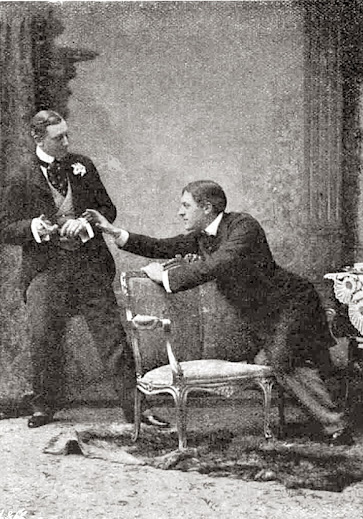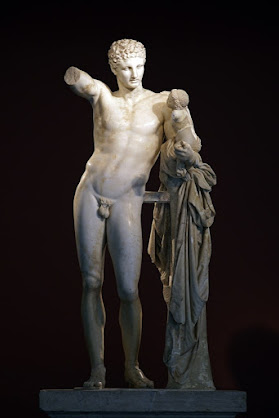Victorian Shadows: Negotiating Homosexuality in the Late-1800s.
Gay artists and writers of the mid-to-late nineteenth-century could not identify themselves as homosexual as the term did not come into common usage until after the turn of the century. Indeed, the very notion that someone was predetermined to same sex attraction was completely outside of contemporary thought. Rather, it was believed that men could occasionally have spiritual or moral lapses.
The word ‘homo-sexuality’ entered the OED only in 1892 …That the terms ‘heterosexual’ and ‘heterosexuality’ were coined even later (1900) suggests that what is at stake in this particular naming process is a distinctly modern epistemology not only of ‘deviance’ but of ‘normalcy’.[1]
Gay men would have had only a nagging notion of their difference, and a strong sense that this difference was wrong. It was a time when gay men by necessity lived deep within the shadows, but the shadows were vague and what they obscured was unnamed and unidentifiable. Before the clinical name ‘homosexual’ became commonplace, gay Victorians were merely shamed with reference to their abominable sexual activities - ‘pederast’, ‘sodomite’, ‘bugger’ – as if such indulgences were merely lapses of common sense and judgement; something that any man - even a heterosexual man - might find himself committing were he to topple into a moral abyss. The new terminology - ‘homosexual’ - would eventually shift the meaning from the act, to the character of the person and this made the identification and accompanying vilification of gay men much more personalised and thorough because they now embodied their sexuality.
Although a blandly descriptive, rigorously clinical term like ‘homosexuality’ would appear to be unobjectionable as a taxonomic device, it carries with it a heavy complement of ideological baggage and has proved a significant obstacle to understanding the distinctive features of sexual life in non-Western and pre-modern cultures.[2]
Given the uncategorised, amorphous nature of homosexuality during this period, it is perhaps natural that gay artists were drawn towards a time in history that named their sexual predilections, and which even tolerated, if not institutionalised them; ancient Greece. By looking back, gay artists could forge ahead; they could write or make imagery about gay subjects without fear of censure and they could legitimise homoerotic and paederastic (and even paedophilic) imagery under the guise of conforming to Classical and Ancient Greek models.
Poetry was not just an invocation of homosexual desire, but also an attempt to define and classify, to order that desire…[It] became a vision of love, a vision of a world where love between men and youths was somehow raised up from its furtive, criminal, despicable status as the crimen tantum horribile non inter Christianos nominandum, to a finer, higher plain, to a Higher Philosophy, as Plato had termed love between men and youths in the Symposium. When Oscar inscribed a copy of his collection of essays, Intentions, for Lord Alfred Douglas, he wrote ‘Bosie, from his friend the author … In memory of the Higher Philosophy.[3]
Museums became a natural congregating areas for gay men; the Greek statue rooms at the British Museum were one place where Victorian, and later, Edwardian men could legitimately go and look at the naked male form without fear of arrest.[4]
Within Victorian arts and literature, one manifestation of this interest in Ancient Greece and its institutionalised paederasty was Uranianism, which became a voguish philosophical and aesthetic ‘movement’. Much lauded by eminent Victorian gay artists and writers, including, Walter Pater, John Addington Symonds, Gerard Manley Hopkins and most notably Oscar Wilde, all of whom adopted its tenets, it took its inspiration from certain classical and ancient Greek sources. Often closely linked to the Aesthetic movement, it stood as a general coded reference for homosexuality; but what the ‘movement’ actually stood for, in concrete terms, was conveniently vague, depending upon the needs of the practitioner. This mutability of intention is evident in the most famous public explanation of its ideals, which came from Wilde at his first trial in 1895. Asked to explain the code phrase ‘The Love that dare not speak its name', which had appeared in two incriminating letters, he plaintively stated,
‘The Love that dare not speak its name' in this century is such a great affection of an elder for a younger man as there was between David and Jonathan, such as Plato made the very basis of his philosophy, and such as you find in the sonnets of Michelangelo and Shakespeare. It is that deep, spiritual affection that is as pure as it is perfect. It dictates and pervades great works of art like those of Shakespeare and Michelangelo, and those two letters of mine, such as they are. It is in this century misunderstood, so much misunderstood that it may be described as the ‘Love that dare not speak its name’, and on account of it I am placed where I am now. It is beautiful, it is fine, it is the noblest form of affection. There is nothing unnatural about it. It is intellectual, and it repeatedly exists between an elder and a younger man, when the elder man has intellect, and the younger man has all the joy, hope and glamour of life before him. That it should be so the world does not understand. The world mocks at it and sometimes puts one in the pillory for it.[5]
Under the circumstances, his disingenuous response to questions about his relations with youths is understandable. Wilde sought to explain away his interest in young men as anodyne; cerebral and cultural rather than carnal. In his effort to explain his homosexuality in a time when there was no defining explanation possible, Wilde desperately enlists not only the Ancient Greek justification put forward by Plato, but biblical characters and he also refers to Michelangelo and Shakespeare who, he must have surmised, by their sheer unarguable genius could surely be counted on to validate male/male desire. His strategy did not pay off, however. The Love may not have dared to speak its name, but it is probably more accurate to say that it could not speak its name – there was simply no name for it.[6]
[1] David Halpern, One Hundred Years of Homosexuality and Other Essays on Greek Love, Routledge, London & NY, 1990, p.6
[2] Ibid p.18
[3] Neil McKenna, The Secret Life of Oscar Wilde, , Century, London, 2003, p.88.
[4] It is apposite that one of the closing scenes of E M Forster’s novel Maurice is set in the British Museum. Maurice’s lover threatens to reveal their criminal homosexual relationship to a passing acquaintance.
[5] Quoted in McKenna p. 391
[6] The word Homosexualität appears for the first time in a letter from the German-Hungarian Károly Mária Kertbeny (born Karl Maria Benkert; 1824–82) to Karl Heinrich Ulrichs dated 6 May 1868, and then in two pamphlets published in 1869 in Leipzig arguing for reform of Paragraph 143 of the Prussian Penal Code penalising sexual relations between men. Kertbeny’s noun for the male homosexual was Homosexualisten. He invented the word as a neutral and non prejudicial term to argue that it was a natural occurrence, and should be a matter of private behaviour, beyond the reaches of law. His aim was the protection of a minority group.





Comments
Post a Comment